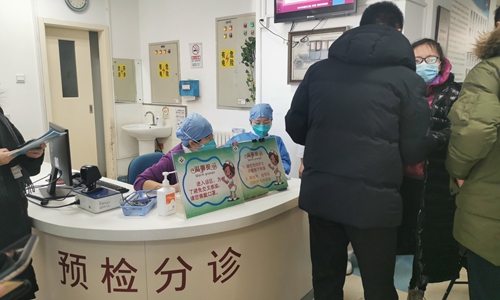Chaoyang district in Beijing the only 'high-risk' COVID-19 area in China
By Zhang Hui and Leng Shumei Source:Global Times Published: 2020/4/20 17:38:40

Beijing Chaoyang Hospital Photo: Hu Yuwei/GT
Beijing's Chaoyang district is classified as the only district in China with a "high risk" of COVID-19 infection, according to official categorization, followed by northeastern city Suifenhe and two districts in South China's Guangzhou that are categorized as having medium risk due to the threat brought by imported cases.
The capital city has lifted the 14-day quarantine requirement for people coming from neighboring Hebei Province or Tianjin Municipality, a move that represents the complexity of the epidemic control work in Beijing, analysts said.
Chaoyang district has been identified as a high-risk COVID-19 area as of 6 pm on Sunday, with media reports saying it is the only "high-risk" area in China in the official system, triggering concerns among local residents over the epidemic situation in the district as well as in the capital.
Areas that have reported more than 50 COVID-19 cases in total and discovered cluster transmissions in the last 14 days are ranked as high-risk COVID-19 areas in China, Pang Xinghuo, deputy director of the Beijing Centers for Disease Control and Prevention, said at a press conference on Monday.
The move came after local authorities confirmed three new COVID-19 cases in a Chaoyang community, who are all from the same family of an imported case from the US reported on April 14, constituting a cluster transmission case, according to Pang.
The move triggered heavy concern on social media platforms amid viral reports on Monday. Chaoyang residents expressed worry over the epidemic situation in the district and how the ranking would affect their lives, and they wondered if they would be asked to undergo a 14-day quarantine if they left the district.
Some were also worried that the move indicates the high threat of imported cases to the capital in general.
According to some posts circulating online, relatives of the cases mentioned above had been to an outlet store in Chaoyang and a water park in Shunyi district before they were confirmed to be infected.
The Global Times contacted the water park in Shunyi on Monday, which said that it had not discovered transmission in the park and is operating as normal.
Beijing authorities have isolated related cases, tracked close contacts and conducted nucleic acid tests on neighbors of the above-mentioned cases. Places they went to before being confirmed infected have all been disinfected, Pang noted at the press conference, vowing to enhance epidemic prevention and control measures in the capital.
Despite growing imported cases and cases related to them, Beijing has not reported domestic cases for more than 25 continuous days. The capital as a whole is at a low COVID-19 risk level, according to local officials.
Beijing has stopped telling arrivals from neighboring Hebei and Tianjin to undergo a 14-day quarantine if they stayed more than 14 days in those two places before coming to Beijing, Xu Ying, an official from the Beijing government, announced at the Monday press conference.
Before the announcement, all arrivals from other provinces and regions to Beijing had to undergo a 14-day quarantine.
The easing restrictions on the influx of people combined with the upgrade of Chaoyang's risk level show the complexity of epidemic control in the capital city, an political, economic and cultural center.
While most parts of China, including the hardest-hit Wuhan, have been classified as low risk, seven locations, including Yuexiu and Baiyun districts in South China's Guangzhou and Suifenhe in Northeast China's Heilongjiang Province, are still considered medium-risk areas due to the threat of imported cases.
The risk level of more than 3,000 areas in China are shown on a service program of the State Council, China's Cabinet, on WeChat.
Posted in: SOCIETY,CHINA FOCUS